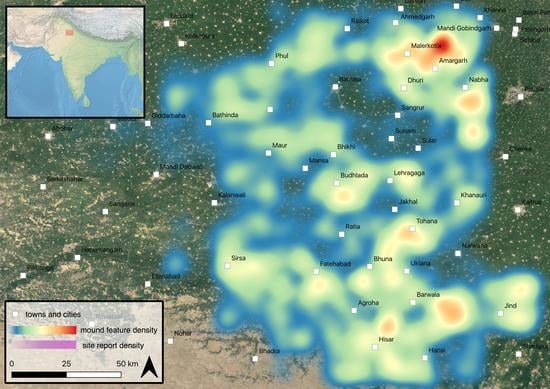Re-Discovering Ancient Landscapes: Archaeological Survey of Mound Features from Historical Maps in Northwest India and Implications for Investigating the Large-Scale Distribution of Cultural Heritage Sites in South Asia
Abstract
:1. Introduction
1.1. Historical Maps, GIS and Remote Sensing
1.2. Archaeological Survey in Northwest India
1.3. Survey of India Maps and Northwest India
2. Materials and Methods
2.1. Study Area
2.2. Filtering Criteria
2.3. Field Assessments
3. Results
4. Discussion
5. Conclusions
Supplementary Materials
Author Contributions
Funding
Acknowledgments
Conflicts of Interest
References
- Wilkinson, T.J. Archaeological Landscapes of the Near East; University of Arizona Press: Tucson, AZ, USA, 2003. [Google Scholar]
- Lawrence, D.; Bradbury, J. Chronology, uncertainty and GIS: A methodology for characterising and understanding landscapes of the ancient Near East. eTopoi 2012, 3, 353. [Google Scholar]
- Lawrence, D.; Philip, G.; Wilkinson, K.; Buylaert, J.P.; Murray, A.S.; Thompson, W.; Wilkinson, T.J. Regional power and local ecologies: Accumulated population trends and human impacts in the northern Fertile Crescent. Quat. Int. 2015, 437, 1–22. [Google Scholar] [CrossRef]
- Green, A.S.; Petrie, C.A. Landscapes of Urbanization and De-Urbanization: A Large-Scale Approach to Investigating the Indus Civilization’s Settlement Distributions in Northwest India. J. Field Archaeol. 2018, 43, 284–299. [Google Scholar] [CrossRef]
- Petrie, C.A.; Orengo, H.; Green, A.; Walker, J.; Garcia, A.; Conesa, F.; Knox, J.; Singh, R.N. Mapping Archaeology While Mapping an Empire: Using Historical Maps to Reconstruct Ancient Settlement Landscapes in Modern India and Pakistan. Geosciences 2019, 9, 11. [Google Scholar] [CrossRef]
- Kenoyer, J.M. Early City-States in South Asia: Comparing the Harappan Phase and the Early Historic Period. In The Archaeology of City-States: Cross-Cultural Approaches; Nichols, D.L., Charlton, T.H., Eds.; Smithsonian Series in Archaeological Inquiry; Smithsonian Institution Press: Washington, DC, USA, 1997; pp. 51–70. [Google Scholar]
- Possehl, G.L. The Indus Civilization: A Contemporary Perspective; AltaMira Press: Walnut Creek, CA, USA, 2002. [Google Scholar]
- Chakrabarti, D.K. India: An Archaeological History: Palaeolithic Beginnings to Early Historic Foundations, 2nd ed.; Oxford University Press: New Delhi, India, 2009. [Google Scholar]
- Wright, R.P. The Ancient Indus: Urbanism, Economy and Society; Cambridge University Press: Cambridge, UK, 2010. [Google Scholar]
- Ratnagar, S.F. Harappan Archaeology: Early State Perspectives; Primus Books: Delhi, Indian, 2016. [Google Scholar]
- Shinde, V.S. Current Perspectives on the Harappan Civilization. In A Companion to South Asia in the Past; Schug, G.R., Walimbe, S.R., Eds.; John Wiley & Sons: Hoboken, NJ, USA, 2016; pp. 127–144. [Google Scholar]
- Petrie, C.A.; Singh, R.N. Investigating Cultural and Geographical Transformations from the Collapse of Harappan Urbanism to the Rise of the Great Early Historic Cities: A Note on the Land, Water, and Settlement Project. South Asian Stud. 2008, 24, 37–38. [Google Scholar]
- Singh, R.N.; Petrie, C.A.; French, C.A.; Goudie, A.S.; Gupta, S.; Tewari, R.; Singh, A.K.; Sinha, R.; Srivastava, R.; Yadav, S. Settlements in context: Reconnaissance in Western Uttar Pradesh and Haryana. Man Environ. 2008, 33, 71–87. [Google Scholar]
- Singh, R.N.; Singh, M.; Petrie, C.A. Addressing problems of context: The Rakhigarhi Hinterland Survey-2009. Manaviki 2010, 1, 24–28. [Google Scholar]
- Casana, J. Alalakh and the Archaeological Landscape of Mukish: The Political Geography and Population of a Late Bronze Age Kingdom. Bull. Am. Sch. Orient. Res. 2009, 353, 7–37. [Google Scholar] [CrossRef]
- Chase, A.F.; Chase, D.Z.; Weishampel, J.F.; Drake, J.B.; Shrestha, R.L.; Slatton, K.C.; Awe, J.J.; Carter, W.E. Airborne LiDAR, archaeology, and the ancient Maya landscape at Caracol, Belize. J. Archaeol. Sci. 2011, 38, 387–398. [Google Scholar] [CrossRef]
- Ur, J.; de Jong, L.; Giraud, J.; Osborne, J.F.; MacGinnis, J. Ancient Cities and Landscapes in the Kurdistan Region of Iraq: The Erbil Plain Archaeological Survey 2012 Season. Iraq 2013, 75, 89–117. [Google Scholar] [CrossRef] [Green Version]
- Tapete, D. Remote Sensing and Geosciences for Archaeology. Geosciences 2018, 8, 41. [Google Scholar] [CrossRef]
- Garcia, A.; Orengo, H.; Conesa, F.; Green, A.; Petrie, C.A. Remote Sensing and Historical Morphodynamics of Alluvial Plains. The 1909 Indus Flood and the City of Dera Gazhi Khan (Province of Punjab, Pakistan). Geosciences 2019, 9, 21. [Google Scholar] [CrossRef]
- Joshi, J.P.; Madhu, B.; Jassu, R. The Indus Civilization: A reconsideration on the basis of distribution maps. In Frontiers of the Indus Civilization, Sir Mortimer Wheeler Commemoration Volume; Lal, B.B., Gupta, P., Eds.; Books & Books: New Delhi, India, 1984. [Google Scholar]
- Possehl, G.L. Indus Age: The Beginnings; University of Pennsylvania Press: Philadelphia, PA, USA, 1999. [Google Scholar]
- Chakrabarti, D.K.; Saini, S. The Problem of the Sarasvati River and Notes on the Archaeological Geography of Haryana and Indian Panjab; Aryan Books International: New Delhi, India, 2009. [Google Scholar]
- Kumar, M. Harappan Settlements in the Ghaggar-Yamuna Divide. In Occasional Paper 7: Linguistics, Archaeology and the Human Past; Osada, T., Uesugi, A., Eds.; Research Institute for Humanity and Nature: Kyoto, Japan, 2009; pp. 1–24. [Google Scholar]
- Rondelli, B.; Stride, S.; García-Granero, J.J. Soviet military maps and archaeological survey in the Samarkand region. J. Cult. Herit. 2013, 14, 270–276. [Google Scholar] [CrossRef]
- Balbo, A.L.; Rondelli, B.; Cecília Conesa, F.; Lancelotti, C.; Madella, M.; Ajithprasad, P. Contributions of geoarchaeology and remote sensing to the study of Holocene hunter–gatherer and agro-pastoral groups in arid margins: The case of North Gujarat (Northwest India). Quat. Int. 2013, 308, 53–65. [Google Scholar] [CrossRef]
- Conesa, F.C.; Madella, M.; Galiatsatos, N.; Balbo, A.L.; Rajesh, S.V.; Ajithprasad, P. CORONA Photographs in Monsoonal Semi-arid Environments: Addressing Archaeological Surveys and Historic Landscape Dynamics over North Gujarat, India: CORONA Photographs in Monsoonal Semi-arid North Gujarat, India. Archaeol. Prospect. 2015, 22, 75–90. [Google Scholar] [CrossRef]
- Wheatley, D.; Gillings, M. Spatial Technology and Archaeology: The Archaeological Applications of GIS; Taylor & Francis: New York, NY, USA, 2002. [Google Scholar]
- Kintigh, K. The Promise and Challenge of Archaeological Data Integration. Am. Antiq. 2006, 71, 567. [Google Scholar] [CrossRef]
- Conolly, J.; Lake, M. Geographical Information Systems in Archaeology; Cambridge Manuals in Archaeology; Cambridge University Press: Cambridge, UK, 2006. [Google Scholar]
- Snow, D.R. Making Legacy Literature and Data Accessible in Archaeology. In Making History Interactive. Com-Puter Applications and Quantitative Methods in Archaeology; Frischer, B., Crawford, J., Koller, D., Eds.; BAR International Series S2079; Archaoepress: Oxford, UK, 2010; pp. 350–355. [Google Scholar]
- Cooper, A.; Green, C. Embracing the Complexities of ‘Big Data’ in Archaeology: The Case of the English Landscape and Identities Project. J. Archaeol. Method Theory 2015, 23, 271–304. [Google Scholar] [CrossRef]
- Green, A.S. Mohenjo-Daro’s Small Public Structures: Heterarchy, Collective Action and a Re-visitation of Old Interpretations with GIS and 3D Modelling. Camb. Archaeol. J. 2018, 28, 205–223. [Google Scholar] [CrossRef]
- Smith, S.; Chambrade, M.-L. The Application of Freely-Available Satellite Imagery for Informing and Complementing Archaeological Fieldwork in the “Black Desert” of North-Eastern Jordan. Geosciences 2018, 8, 491. [Google Scholar] [CrossRef]
- Luo, L.; Wang, X.; Guo, H.; Lasaponara, R.; Shi, P.; Bachagha, N.; Li, L.; Yao, Y.; Masini, N.; Chen, F.; et al. Google Earth as a Powerful Tool for Archaeological and Cultural Heritage Applications: A Review. Remote Sens. 2018, 10, 1558. [Google Scholar] [CrossRef]
- Elfadaly, A.; Lasaponara, R. On the Use of Satellite Imagery and GIS Tools to Detect and Characterize the Urbanization around Heritage Sites: The Case Studies of the Catacombs of Mustafa Kamel in Alexandria, Egypt and the Aragonese Castle in Baia, Italy. Sustainability 2019, 11, 2110. [Google Scholar] [CrossRef]
- Verhoeven, G.J.J. Providing an archaeological bird’s-eye view—An overall picture of ground-based means to execute low-altitude aerial photography (LAAP) in Archaeology. Archaeol. Prospect. 2009, 16, 233–249. [Google Scholar] [CrossRef]
- Verhoeven, G.; Sevara, C.; Karel, W.; Ressl, C.; Doneus, M.; Briese, C. Undistorting the past: New techniques for orthorectification of archaeological aerial frame imagery. In Good Practice in Archaeological Diagnostics: Non-Invasive Survey of Complex Archaeological Sites; Corsi, C., Slapšak, B., Vermeulen, F., Eds.; Natural Science in Archaeology; Springer: Berlin/Heidelberg, Germany, 2013. [Google Scholar]
- Parcak, S.H. Remote Sensing in Archaeology; Wiseman, J., El-Baz, F., Eds.; Interdisciplinary Contributions to Archaeology; Springer: Berlin/Heidelberg, Germany, 2007. [Google Scholar]
- Masini, N.; Gizzi, F.; Biscione, M.; Fundone, V.; Sedile, M.; Sileo, M.; Pecci, A.; Lacovara, B.; Lasaponara, R. Medieval Archaeology under the Canopy with LiDAR. The (Re) Discovery of a Medieval Fortified Settlement in Southern Italy. Remote Sens. 2018, 10, 1598. [Google Scholar] [CrossRef]
- Magli, G. The Sacred Landscape of the “Pyramids” of the Han Emperors: A Cognitive Approach to Sustainability. Sustainability 2019, 11, 789. [Google Scholar] [CrossRef]
- Petrie, C.A. Remote sensing in inaccessible lands: Plains and preservation along old routes between Pakistan and Afghanistan. ArchAtlas 2007, 3. [Google Scholar] [CrossRef]
- Casana, J.; Laugier, E.J. Satellite imagery-based monitoring of archaeological site damage in the Syrian civil war. PLoS ONE 2017, 12, e0188589. [Google Scholar] [CrossRef] [PubMed]
- Orengo, H.A.; Krahtopoulou, A.; Garcia-Molsosa, A.; Palaiochoritis, K.; Stamati, A. Photogrammetric re-discovery of the hidden long-term landscapes of western Thessaly, central Greece. J. Archaeol. Sci. 2015, 64, 100–109. [Google Scholar] [CrossRef]
- Hammer, E.; Seifried, R.; Franklin, K.; Lauricella, A. Remote assessments of the archaeological heritage situation in Afghanistan. J. Cult. Herit. 2018, 33, 125–144. [Google Scholar] [CrossRef] [Green Version]
- Hammer, E.; Ur, J. Near Eastern Landscapes and Declassified U2 Aerial Imagery. Adv. Archaeol. Pract. 2019, 7, 1–20. [Google Scholar] [CrossRef]
- Wright, R.; Hritz, C. Satellite Remote Sensing Imagery: New Evidence for Sites and Ecologies in the Upper Indus. In South Asian Archaeology 2007; BAR International Series: Oxford, UK, 2013; pp. 315–321. [Google Scholar]
- Prabhakar, V.N.; Korisettar, R. Ground Survey to Aerial Survey:Methods and Best Practices in Systematic Archaeological Explorations and Excavations. Curr. Sci. 2017, 113, 1873. [Google Scholar] [CrossRef]
- Petrie, C.A.; Lynam, F. Revisiting settlement contemporaneity and exploring stability and instability: Case-studies from the Indus Civilisation, Journal of Field Archaeology 45.1. J. Field Archaeol. 2019, 45. [Google Scholar] [CrossRef]
- Orengo, H.A.; Conesa, F.C.; Garcia, A.; Green, A.S.; Petrie, C.A. Living on the edge of the desert: Automated detection of archaeological mounds in Cholistan (Pakistan) using machine learning classification of multi-sensor and multi-temporal satellite data 2019. In Preparation.
- Petrie, C.A.; Singh, R.N.; Bates, J.; Dixit, Y.; French, C.A.I.; Hodell, D.A.; Jones, P.J.; Lancelotti, C.; Lynam, F.; Neogi, S.; et al. Adaptation to Variable Environments, Resilience to Climate Change: Investigating Land, Water and Settlement in Indus Northwest India. Curr. Anthropol. 2017, 58, 1–30. [Google Scholar] [CrossRef]
- Petrie, C.A. South Asia. In The Oxford Handbook of Cities in World History; Oxford University Press: Oxford, UK, 2013; pp. 83–104. [Google Scholar]
- Sinopoli, C.M. Ancient South Asian cities in their regions. In The Cambridge World History; Yoffee, N., Ed.; Cambridge University Press: Cambridge, UK, 2015; pp. 319–342. [Google Scholar]
- Wright, R.P. Comparative Perspectives and Early States Revisited. In State Formations; Brooke, J.L., Strauss, J.C., Anderson, G., Eds.; Cambridge University Press: Cambridge, UK, 2018. [Google Scholar]
- Wright, R.P.; Schuldenrein, J.; Khan, M.A.; Mughal, M. The emergence of satellite communities along the Beas drainage: Preliminary results from Lahoma Lal Tibba and Chak Purbane Syal. South Asian Archaeol. 2001, 1, 327–336. [Google Scholar]
- Wright, R.P.; Schuldenrein, J.; Khan, M.A.; Malin-Boyce, S. The Beas River Landscape and Settlement Survey: Preliminary Results from the Site of Vainiwal. In South Asian Archaeology 2003; Franke-Vogt, U., Weisshar, H.J., Eds.; Linden Soft: Aachen, Germany, 2003. [Google Scholar]
- Parikh, D.; Petrie, C.A. ‘We are inheritors of a rural civilisation’: Rural complexity and the ceramic economy in the Indus Civilisation in northwest India. World Archaeol. 2018. [Google Scholar] [CrossRef]
- Singh, R.N.; Petrie, C.A.; Pawar, V.; Pandey, A.K.; Parikh, D. New Insights into Settlement along the Ghaggar and its Hinterland: A Preliminary Report on the Ghaggar Hinterland Survey 2010. Man Environ. 2011, 36, 89–106. [Google Scholar]
- Singh, R.N.; Green, A.S.; Ranjan, A.; Green, L.M.; Alam, A.; Petrie, C.A. Between the Hinterlands: Preliminary Results from the TwoRains Survey in Northwest India 2017. Man Environ. 2018, 43, 84–102. [Google Scholar]
- Singh, U. Delhi: Ancient History; Readings in History; Social Science Press: New Delhi, India, 2006. [Google Scholar]
- Singh, U. A History of Ancient and Early Medieval India: From the Stone Age to the 12th Century; Pearson Education: New Delhi, India, 2008. [Google Scholar]
- Phadke, H.A. Haryana, Ancient and Medieval; Harman Pub. House: New Delhi, India, 1990. [Google Scholar]
- Flam, L. The Paleogeography and Prehistoric Settlement Patterns in Sind, Pakistan (CA. 4000-2000 B.C.). Ph.D. Thesis, University of Pennsylvania, Philadelphia, PA, USA, 1981. [Google Scholar]
- Mughal, M.R. Ancient Cholistan: Archaeology and Architecture; Ferozsons: Lahore, Pakistan, 1997. [Google Scholar]
- Singh, R.N.; Petrie, C.A.; Pawar, V.; Pandey, A.K.; Neogi, S.; Singh, M.; Singh, A.K.; Parikh, D.; Lancelotti, C. Changing patterns of settlement in the rise and fall of Harappan urbanism and beyond: A preliminary report on the Rakhigarhi Hinterland Survey 2009. Man Environ. 2010, 37, 37–53. [Google Scholar]
- Teramura, H.; Uno, T. Spatial Analyses of Harappan Urban Settlements. Anc. Asia 2006, 1, 73. [Google Scholar] [CrossRef] [Green Version]
- Giosan, L.; Clift, P.D.; Macklin, M.G.; Fuller, D.Q.; Constantinescu, S.; Durcan, J.A.; Stevens, T.; Duller, G.A.; Tabrez, A.R.; Gangal, K. Fluvial landscapes of the Harappan civilization. Proc. Natl. Acad. Sci. USA 2012, 109, E1688–E1694. [Google Scholar] [CrossRef]
- Green, A.S.; Bates, J.; Acabado, S.; Coutros, P.R.; Glover, J.B.; Miller, N.F.; Rissolo, D.; Sharratt, N.; Petrie, C.A. How to last a millennium: A global perspective on the long-term social dynamics of resilience and sustainability. PLoS ONE. in preparation.
- Bhan, S. Excavations at Mitathal (Hissar) 1968. J. Haryana Stud. 1969, 1, 1–15. [Google Scholar]
- Bhan, S. Excavation at Mitathal (1968) and Other Explorations; Kurukshetra University: Haryana, India, 1975. [Google Scholar]
- Singh, A. Archaeology of Karnal and Jind Districts [Haryana]. Ph. D. Thesis, Kurukshetra University, Haryana, India, 1981. [Google Scholar]
- Dangi, V. Indus (Harappan) civilization in the Ghaggar Basin. In Current Research on Indus Archaeology; Uesugi, A., Ed.; South Asian Archaeology; Research Group for South Asian Archaeology, Archaeological Research Institute, Kansai University: Osaka, Japan, 2018. [Google Scholar]
- Bisht, R.S. Further Excavations at Banawali: 1983–1984. In Archaeology and History: Essays in Memory of Shri A. Ghosh; Pande, B., Chattopadhyaya, B., Ghosh, A., Eds.; Agam Kala Prakashan: Delhi, India, 1987; pp. 135–156. [Google Scholar]
- Khatri, J.S.; Acharya, M. Kunal: A New Indus-Saraswati Site. Puratattva 1995, 25, 84–86. [Google Scholar]
- Nath, A. Rakhigarhi: A Harappan Metropolis in the Sarasvati-Drishadvati Divide. Puratattva 1998, 28, 39–45. [Google Scholar]
- Nath, A. Further Excavations at Rakhigarhi. Puratattva 1999, 29, 46–49. [Google Scholar]
- Lal, B.B. Excavations at Kalibangan, the Early Harappans, 1960–1969; Archaeological Survey of India: New Delhi, India, 2003. [Google Scholar]
- Nath, A. Rakhigarhi: 1999–2000. Puratattva 2001, 31, 43–45. [Google Scholar]
- Shinde, V.S.; Osada, T.; Sharma, M.M.; Uesugi, A.; Uno, T.; Maemoku, H.; Shirvalkar, P.; Deshpande, S.S.; Kulkarni, A.; Sarkar, A.; et al. Exploration in the Ghaggar Basin and excavations at Girawad, Farmana (Rohtak District) and Mitathal (Bhiwani District), Haryana, India. In Occasional Paper 3: Linguistics, Archaeology and the Human Past; Osada, T., Uesugi, A., Eds.; Indus Project, Research Institute for Humanity and Nature 2008: Kyoto, Japan, 2008. [Google Scholar]
- Shinde, V.S.; Green, A.S.; Parmar, N.; Sable, P.D. Rakhigarhi and the Harappan Civilization: Recent Work and New Challenges. Bull. Deccan Coll. Res. Inst. 2012, 72, 43–53. [Google Scholar]
- Lal, B.B.; Joshi, J.P.; Madhu Bala, A.K.S.; Ramachandran, K.S. Excavations at Kalibangan: The Harappans (1960–1969): Part-1; Archaeological Survey of India: New Delhi, India, 2015. [Google Scholar]
- Osada, T. Environmental change and the Indus civilization: Main outcome of RIHN’s project (2007–2011). Quat. Int. 2012, 279–280, 362. [Google Scholar] [CrossRef]
- Dangi, V.; Osada, T.; Dangi, V. Archaeology of the Ghaggar Basin: Settlement Archaeology of Meham Block, Rohtak, Haryana, India; Linguistics, Archaeology and the Human Past; Research Inst. for Humanity and Nature: Kyoto, Japan, 2009. [Google Scholar]
- Parmar, N. Protohistoric Investigations in the Bhiwani District of Haryana; Deccan College Post Graduate and Research Institute: Pune, India, 2012. [Google Scholar]
- Pawar, V. Archaeological Settlement Pattern of Hanumangarh District (Rajasthan); Maharshi Dayanand University: Rohtak, India, 2012. [Google Scholar]
- Sharan, A.; Pawar, V.; Parmar, N. An Archaeological Reconnaissance of the Proto-historic Settlements in Mansa District, Punjab. Herit. J. Multidiscip. Stud. Archaeol. 2013, 1, 500–514. [Google Scholar]
- Sharan, A. Archaeological Settlement Pattern of Sangrur and Mansa Districts (Punjab); Maharshi Dayanand University: Rohtak, India, 2018. [Google Scholar]
- Singh, R.N.; Green, A.S.; Alam, A.; Petrie, C.A. Beyond the Hinterlands: Preliminary Results from the TwoRains Survey in Northwest India 2018. Man Environ. in press.
- Kantner, J. The Archaeology of Regions: From Discrete Analytical Toolkit to Ubiquitous Spatial Perspective. J. Archaeol. Res. 2008, 16, 37–81. [Google Scholar] [CrossRef]
- Neogi, S. Geoarchaeological Investigations of Indus Settlements in the Plains of North Western India. Ph.D. Thesis, University of Cambridge, Cambridge, UK, 2013. [Google Scholar]
- Neogi, S.; French, C.A.I.; Durcan, J.A.; Singh, R.N.; Petrie, C.A. Geoarchaeological insights into the location of Indus settlements on the plains of northwest India 2019. In Preparation.
- Dangi, V. A Study of Proto-Historic Settlements in Upper Ghaggar Basin; Maharshi Dayanand University: Rohtak, India, 2010. [Google Scholar]
- Orengo, H.A.; Petrie, C.A. Large-scale, multi-temporal remote sensing of palaeo-river networks: A case study from northwest India and its implications for the Indus Civilisation. Remote Sens. 2017, 9, 735. [Google Scholar] [CrossRef]
- Walker, J. Geomorphological studies surrounding the settlements of Lohari Ragho I and Masudpur 2019. In Preparation.
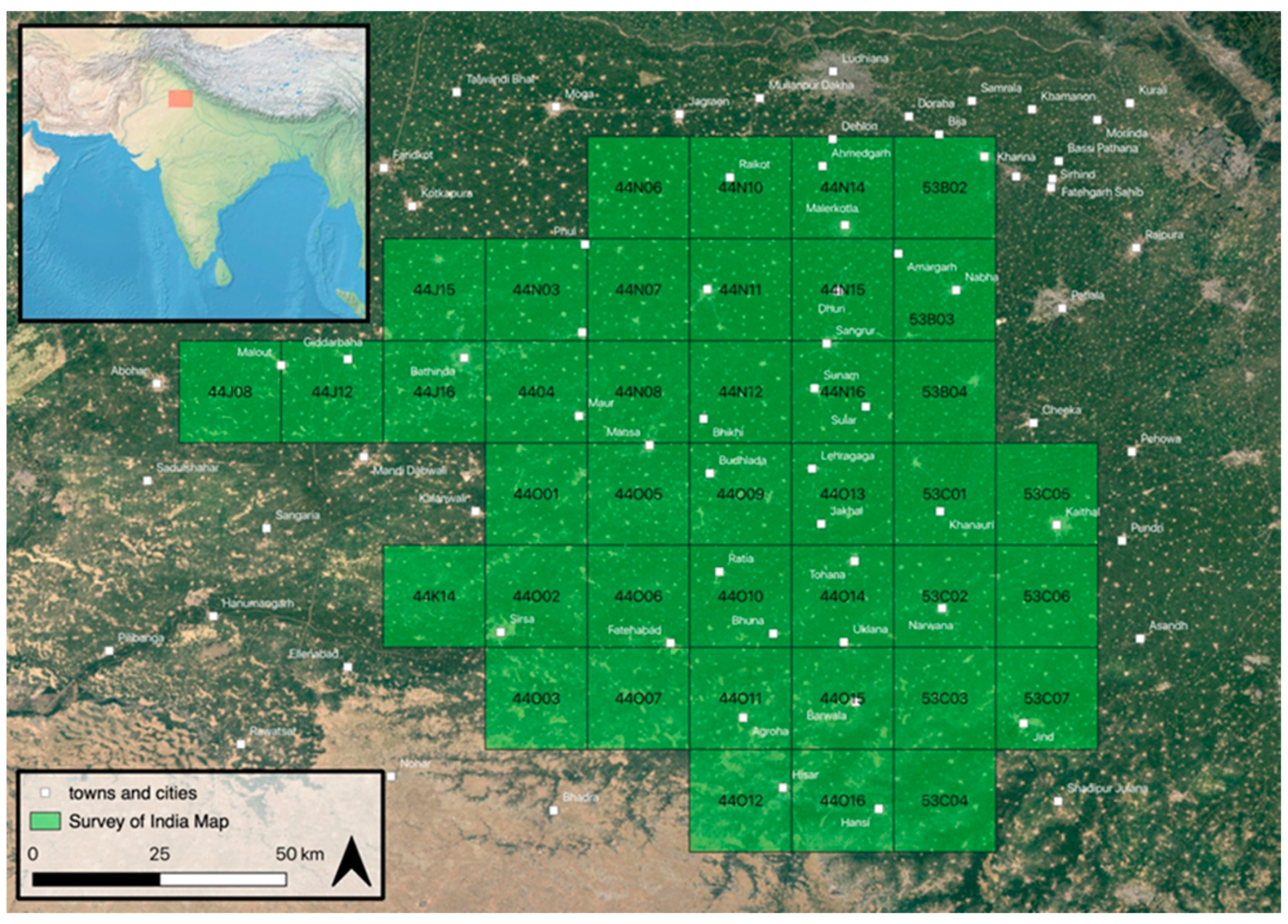
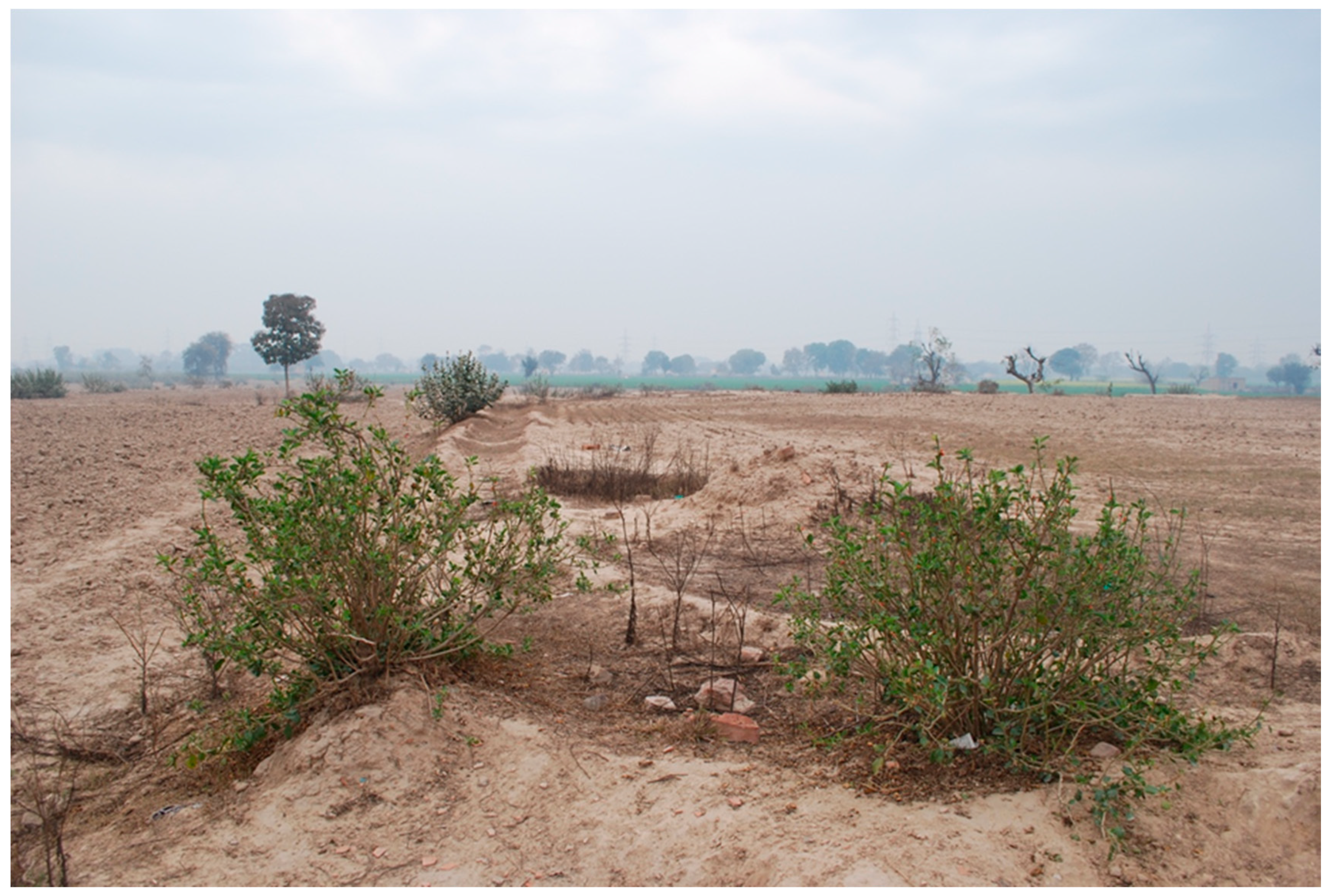
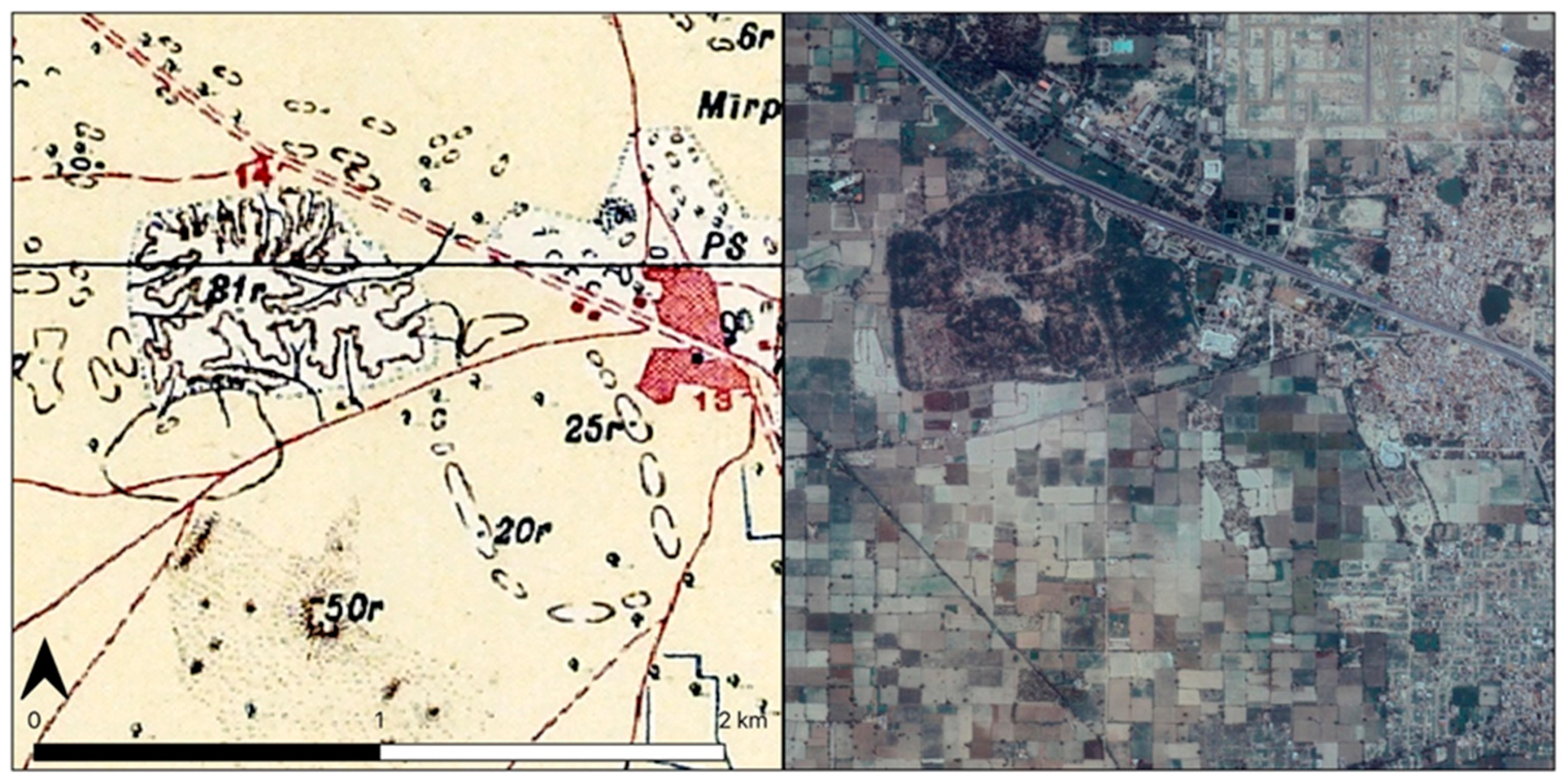

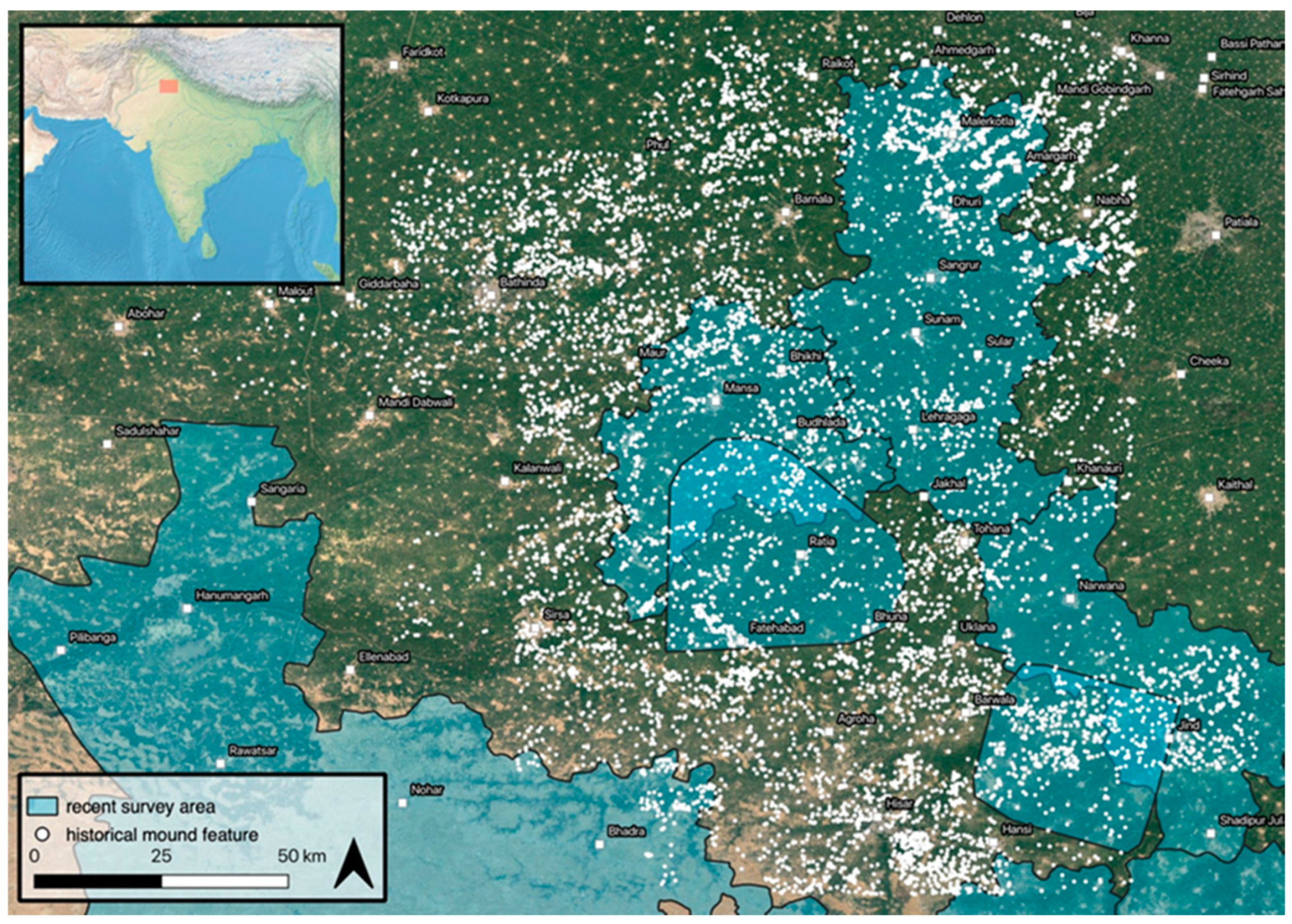





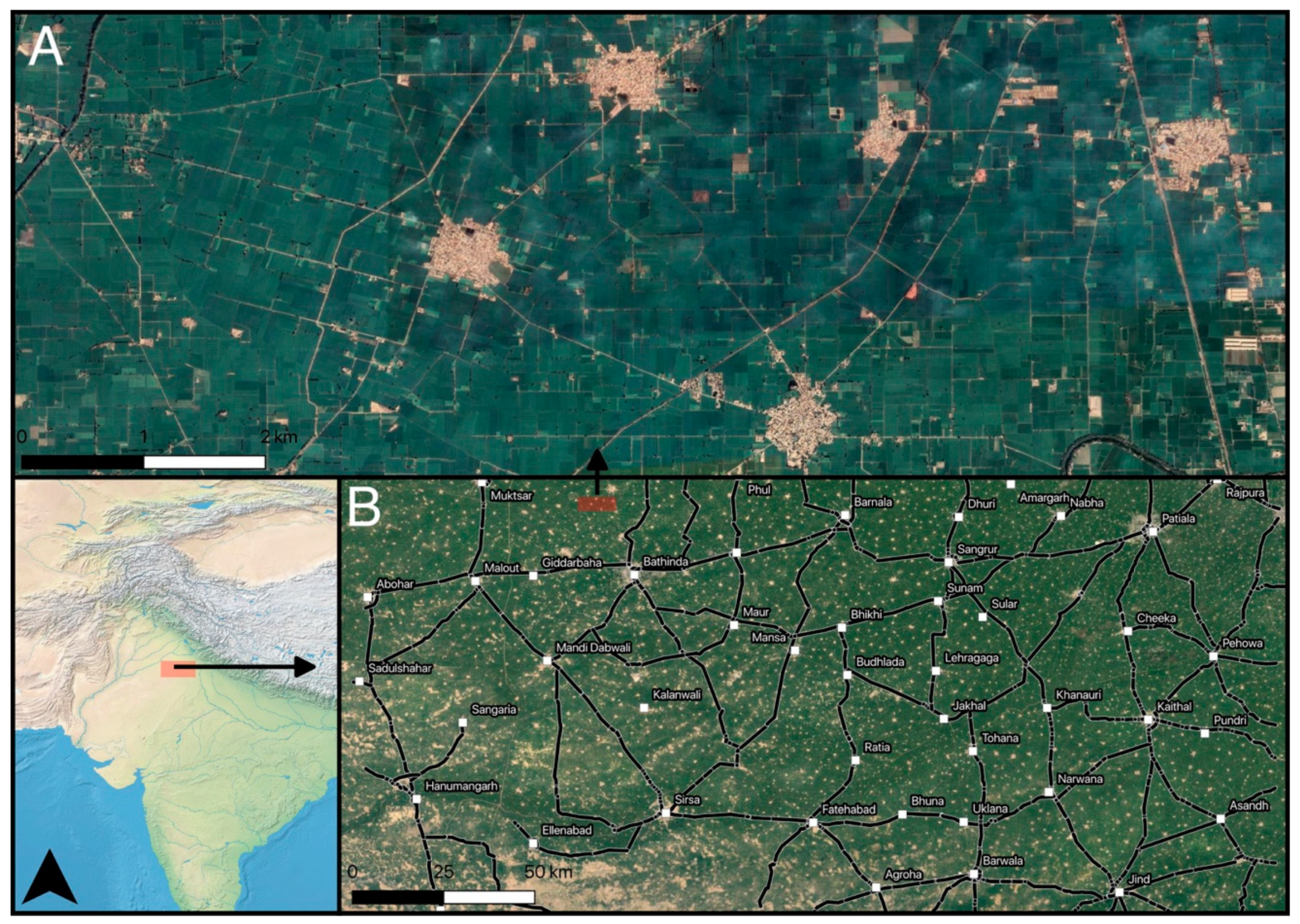




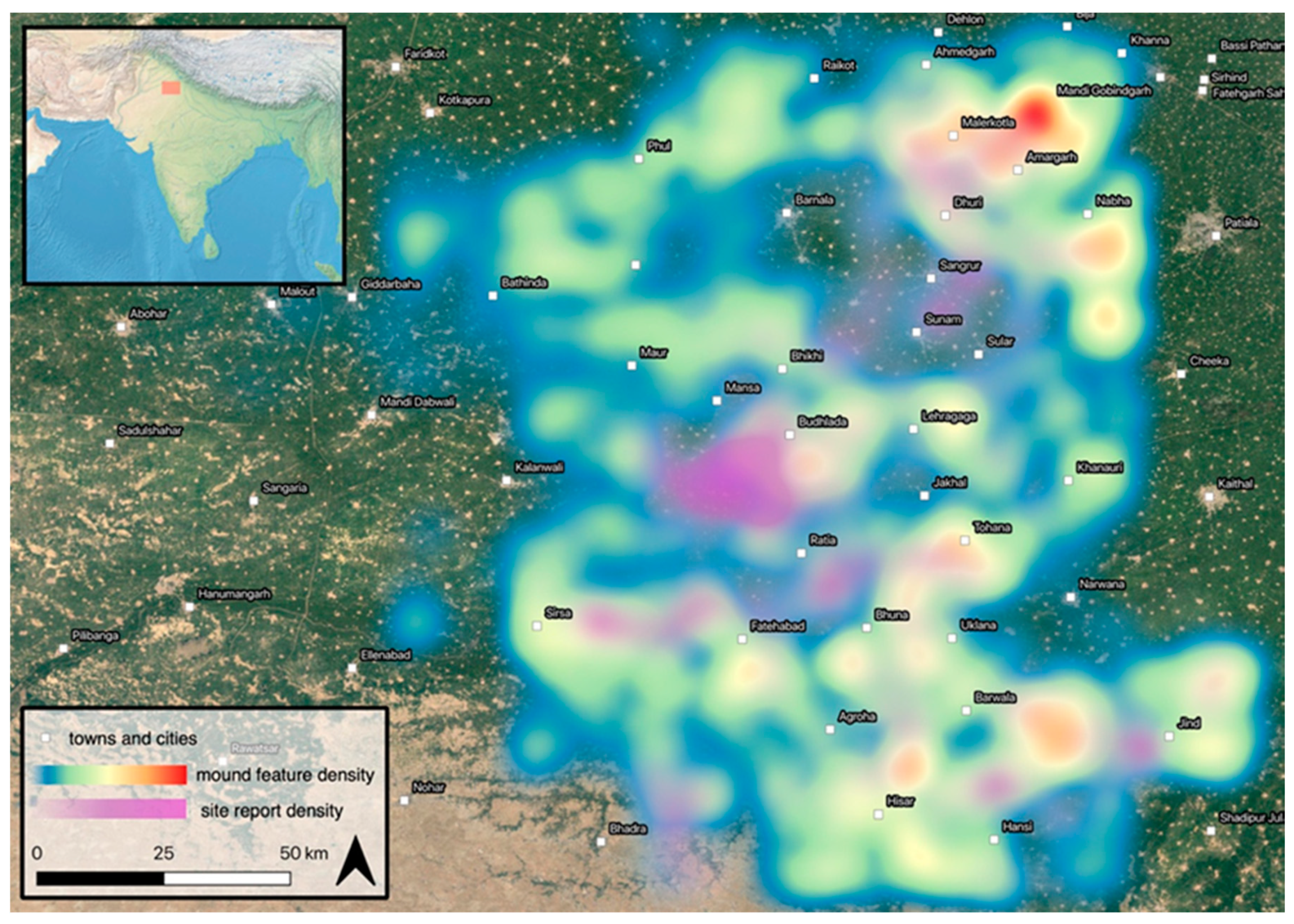
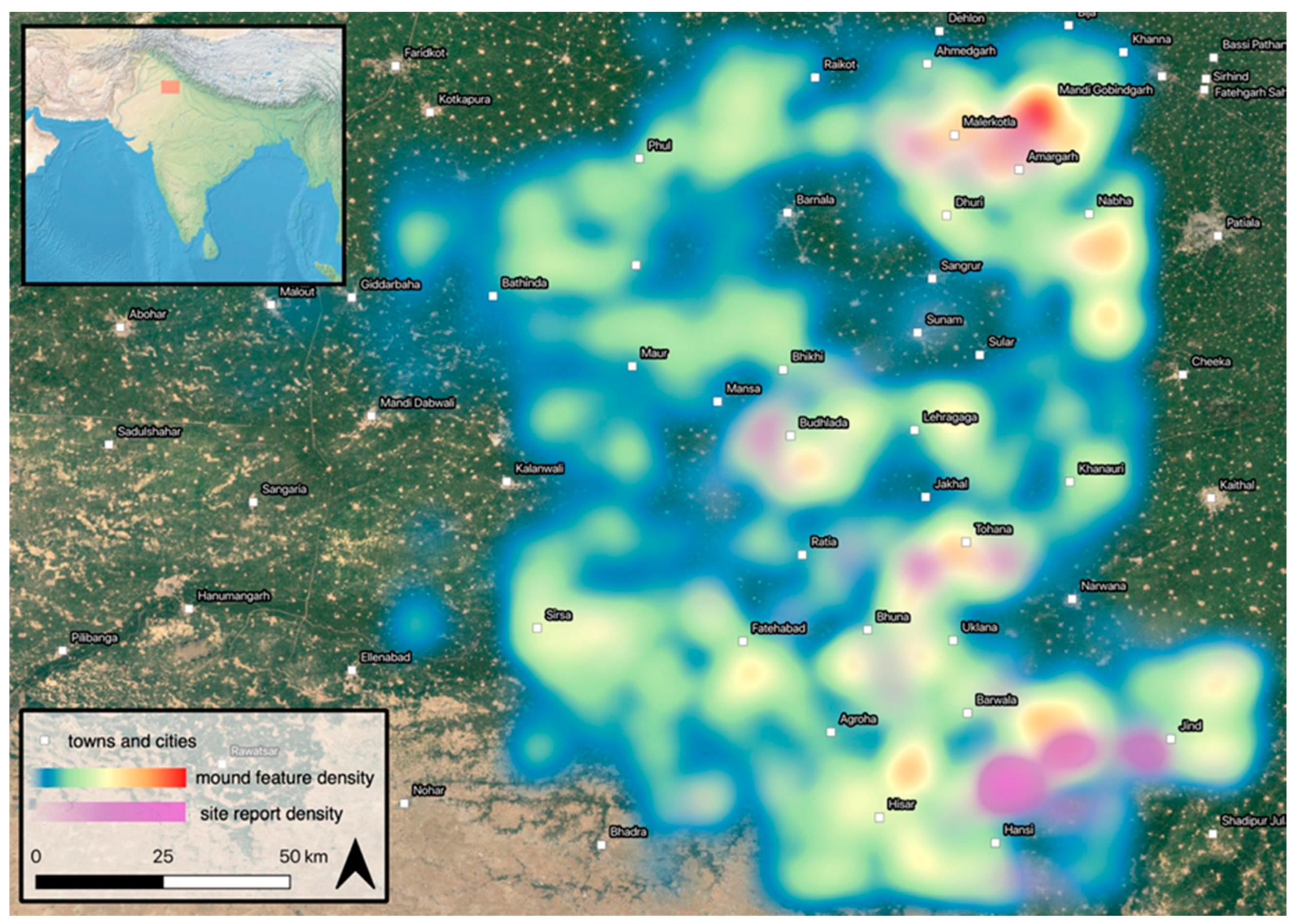

| Feature Type | Total Positive % (n) | Size 3 Positive % (n) | Size 2 Positive % (n) | Size 1 Positive % (n) |
|---|---|---|---|---|
| combined | 40 (5) | 50 (2) | 33.33 (3) | 0 (0) |
| form line | 38.17 (393) | 54.05 (37) | 58.62 (116) | 25.83 (240) |
| shaded | 13.64 (154) | 5.56 (18) | 15.79 (76) | 13.33 (60) |
| hachure | 11.45 (227) | 0 (1) | 40 (25) | 7.96 (201) |
| totals by size | 37.93 (58) | 41.36 (220) | 17.17 (501) |
© 2019 by the authors. Licensee MDPI, Basel, Switzerland. This article is an open access article distributed under the terms and conditions of the Creative Commons Attribution (CC BY) license (http://creativecommons.org/licenses/by/4.0/).
Share and Cite
Green, A.S.; Orengo, H.A.; Alam, A.; Garcia-Molsosa, A.; Green, L.M.; Conesa, F.; Ranjan, A.; Singh, R.N.; Petrie, C.A. Re-Discovering Ancient Landscapes: Archaeological Survey of Mound Features from Historical Maps in Northwest India and Implications for Investigating the Large-Scale Distribution of Cultural Heritage Sites in South Asia. Remote Sens. 2019, 11, 2089. https://doi.org/10.3390/rs11182089
Green AS, Orengo HA, Alam A, Garcia-Molsosa A, Green LM, Conesa F, Ranjan A, Singh RN, Petrie CA. Re-Discovering Ancient Landscapes: Archaeological Survey of Mound Features from Historical Maps in Northwest India and Implications for Investigating the Large-Scale Distribution of Cultural Heritage Sites in South Asia. Remote Sensing. 2019; 11(18):2089. https://doi.org/10.3390/rs11182089
Chicago/Turabian StyleGreen, Adam S., Hector A. Orengo, Aftab Alam, Arnau Garcia-Molsosa, Lillian M. Green, Francesc Conesa, Amit Ranjan, Ravindra N. Singh, and Cameron A. Petrie. 2019. "Re-Discovering Ancient Landscapes: Archaeological Survey of Mound Features from Historical Maps in Northwest India and Implications for Investigating the Large-Scale Distribution of Cultural Heritage Sites in South Asia" Remote Sensing 11, no. 18: 2089. https://doi.org/10.3390/rs11182089
APA StyleGreen, A. S., Orengo, H. A., Alam, A., Garcia-Molsosa, A., Green, L. M., Conesa, F., Ranjan, A., Singh, R. N., & Petrie, C. A. (2019). Re-Discovering Ancient Landscapes: Archaeological Survey of Mound Features from Historical Maps in Northwest India and Implications for Investigating the Large-Scale Distribution of Cultural Heritage Sites in South Asia. Remote Sensing, 11(18), 2089. https://doi.org/10.3390/rs11182089



